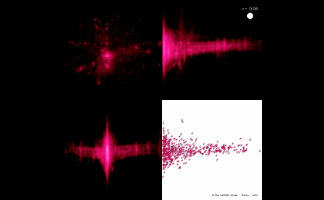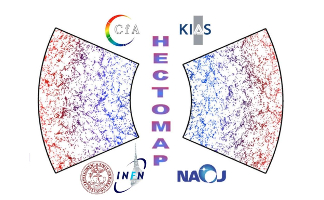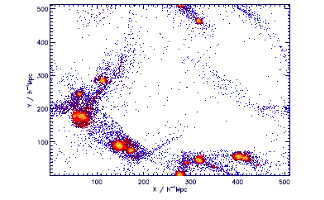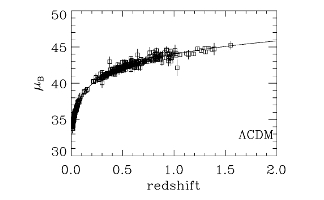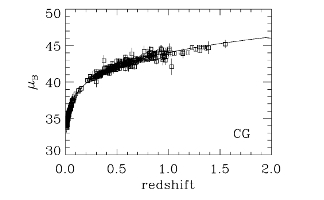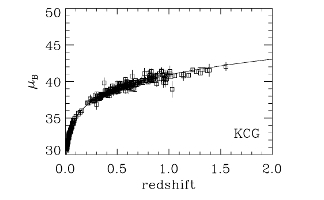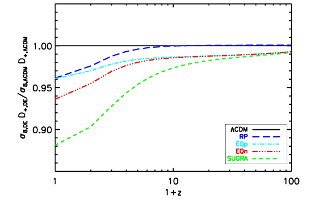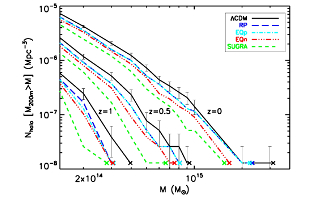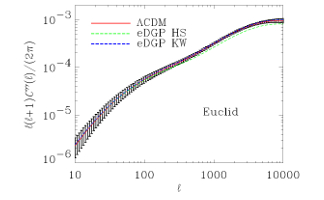Cosmic Structure
We use N-body/hydrodynamical simulations and observations in different bands to investigate the formation and evolution of galaxies, clusters and larger structures. We investigate the role of high-energy astrophysical processes (supernovae explosions and Active Galactic Nuclei energy emission) in the formation efficiency of stars and galaxies. We have also developed the caustic technique, a unique method to estimate the mass of galaxy clusters well beyond the region of dynamical equilibrium. The method is based on galaxy redshifts alone and is complementary to the more popular gravitational lensing techniques.
In 1997, Diaferio and Geller conceived the caustic technique, a completely new and original tool for estimating the mass
in the outskirts of galaxy clusters. This technique opened a new window on the mass estimation on mildly non-linear scale and
has a wider application than weak lensing because it can be applied at any redshift
(Diaferio 1999,
Diaferio 2009
and Serra et al. 2011).
In 1999, for the first time, we measured the mass density
profile of a cluster beyond its virial radius and confirmed
the Navarro, Frenk and White profile on these scales (Geller et al. 1999). With extensive redshift
surveys of the outer regions of clusters
at low (CIRS) and intermediate
redshifts (HeCS), we performed
the only measurement available to date of
the ratio between the masses within the infall and the virial
regions; we show that the measured ratio
agrees with the expected value of the ΛCDM model.
For clusters in the redshift range [0.1-0.3], the caustic masses can
be compared with weak lensing measurements and we can assess the systematic errors of the two approaches
(Diaferio et al. 2005,
Geller et al. 2013).
A by-product of the caustic technique is the identification
of cluster members to large radii: on average, within 3r200, the
technique identifies 95% of the members and returns samples of galaxies
contaminated by a fraction of interlopers of only 8%
(Serra and Diaferio 2013).
The technique was applied to both galaxies in clusters (e.g. Pranger et al. 2013,
Hernandez-Fernandez et al. 2014) and
stars in galaxies (Serra et al. 2010,
Brown et al. 2010).
The Caustic group collaborates with Margaret Geller's group
at the Harvard-Smithsonian Center for Astrophysics to investigate
the cosmic structure on large scales. The largest
structures and voids are powerful tools to constrain models
of structure formation (Sheth and Diaferio 2011,
Colberg et al. 2005).
We are currently completing HectoMAP, a dense redshift survey with median redshift z=0.34 covering 50 deg2 to r = 21
(Geller, Diaferio & Kurtz 2011).
Beyond Standard Gravity and Cosmology
The wealth of cosmological data is currently interpreted with the ΛCDM model: Einstein's cosmological constant and cold dark matter.
However, there is no obvious physical mechanism that can generate the cosmological constant or more sophisticated dark energy fluids, nor is
there any convincing direct or indirect confirmation of the existence of the cold dark matter particle.
We investigate a wide range of extended and modified gravity models, by making the best possible use of all observational constraints to test
the viability of these models at various scales and epochs.
Modified Newtonian Dynamics (MOND) is impressively successful on the scales of galaxies but fails on the scales of galaxy clusters. A model combining MOND with a dark matter component of sterile neutrinos preserves the success of MOND on small scales but does not seem to heal the problems on larger scales (Diaferio & Angus 2012, Angus, Diaferio et al. 2013).
Conformal gravity is able to describe the rotation curves of disk galaxies but appears to fail at reproducing the X-ray properties of clusters (Diaferio & Ostorero, 2009). In addition, conformal gravity predicts an always accelerating universe. At odds with common wisdom, we show that this prediction agrees with current supernovae type Ia and GRB data (Diaferio, Ostorero & Cardone 2011).
An alternative to the cosmological constant can be found in quintessence models, in which dark energy is described by a dynamical scalar field. Several models have been proposed in which the quintessence scalar field can also be coupled to gravity (within scalar-tensor theories) and matter. Quintessence has an impact both on the growth rate of cosmological structure (De Boni et al. 2011) and on the internal properties of gravitationally bound halos (De Boni et al. 2013).
We also investigated how weak lensing surveys can constrain various extended and modified theories of gravity, including f(R), Unified Dark Matter models, and the Dvali, Gabadadze and Porrati model (Camera et al. 2011 a, b, c).
